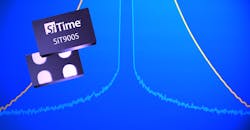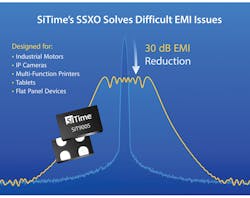Spread Spectrum Trims EMI in MEMS Oscillators
Download this article as a .PDF
Electronic timing functions are traditionally provided by oscillators based on quartz-crystal resonators, although microelectromechanical-systems (MEMS) oscillators are being applied more often in applications once dominated by quartz-crystal oscillators. MEMS oscillators use mechanical structures, such as miniature tuning forks, to achieve resonant frequencies. MEMS devices are fabricated from silicon semiconductor materials and can be made smaller and operate with less power consumption than quartz crystal oscillators.
In addition, with the application of spread-spectrum techniques, as in the case of the SiT9005 MEMS oscillator from SiTime, they can even achieve a significant reduction in electromagnetic interference (EMI) compared to quartz crystal oscillators.
As signal sources, clock oscillators can leak enough EM energy to cause EMI and radio-frequency interference (RFI). In some cases, when clock signal power is high and with fast rise/fall times, sufficient radiation can be generated which can interfere with nearby circuits and/or equipment. Because of this, the FCC sets maximum EMI levels which all electronic equipment must fall below. The SiT9005 helps reduce EMI without additional shielding by using spread-spectrum clock modulation, as well as programmable clock signal rise/fall times.
The MEMS-based SiT9005 provides LVCMOS outputs, available with any frequency from 1 to 141 MHz and with duty cycles ranging from 45 to 55%. The clock oscillator promises as much as 17-dB reduction in EMI for fundamental-frequency outputs and as much as 30-dB reduction in EMI for harmonics. It features outstanding frequency stability of ±20 ppm. The SSXO can be housed in one of three different packages for compatibility with many circuit designs: 2.0 × 1.6 mm, 2.5 × 2.0 mm, and 3.2 × 2.5 mm (see figure).
The SiT9005 is well suited for timing applications in industrial and consumer electronic products—including battery-powered devices, since it operates on low voltages with low current consumption. It is designed for typical supply voltages of +1.8 to +3.3 V dc, with typical current consumption of 5.0 mA for a 40-MHz source running on a +1.8-V dc supply. The typical disable current draw is 4.6 mA for a 40-MHz source running on a +1.8-V dc supply. The typical stand-by current is 0.4 μA for a +1.8-V dc supply, and 2.1 μA for a supply of +2.5 to +3.3 V dc.
The SiT9005 SSXO achieves its low EMI levels by means of different spread-spectrum operating profiles, including a “Hershey’s Kiss”-type spread shape or a triangular spread profile. A total of 28 spread-spectrum options are available for reduced EMI with center spread from ±0.125 to ±2.0% and down spread from −0.25 to −4.0%. In addition, eight FlexEdge configurable rise/fall-time options are available to limit the energy density per unit time, with rise/fall times programmable from 0.25 to 40.0 ns. The spread-spectrum capability can be controlled as needed, with spread enable time of 4 μs or less and spread disable time of 50 μs or less.
For the uninitiated, although MEMS oscillators are essentially mechanical devices, they provide excellent timing stability, with very little jitter or variations between clock cycles. At 40 MHz with spread function on or off and running on a +1.8-V dc supply, the cycle-to-cycle clock jitter is 22 ps or less, and typically only 12.5 ps. For supplies from +2.5 to just under +3.3 V dc, whether the spread spectrum function is on or off, the worst-case cycle-to-cycle jitter is 15 ps and typically 10.5 ps. At +3.3 V dc, with the spread function on or off, the worst-case cycle-to-cycle jitter is 12 ps, and typically 8.5 ps.
The MEMS clock oscillators are RoHS- and REACH-compliant with startup time of 5 ms. They are designed for operating temperatures from −40 to +85ºC for user-selected frequencies from 1 to 141 MHz, and available in three package options that serve as pin-for-pin replacements for quartz crystal oscillators.
SiTime Corp., 5451 Patrick Henry Dr., Santa Clara, CA 95054; (408) 328-4400
About the Author
Jack Browne
Technical Contributor
Jack Browne, Technical Contributor, has worked in technical publishing for over 30 years. He managed the content and production of three technical journals while at the American Institute of Physics, including Medical Physics and the Journal of Vacuum Science & Technology. He has been a Publisher and Editor for Penton Media, started the firm’s Wireless Symposium & Exhibition trade show in 1993, and currently serves as Technical Contributor for that company's Microwaves & RF magazine. Browne, who holds a BS in Mathematics from City College of New York and BA degrees in English and Philosophy from Fordham University, is a member of the IEEE.


